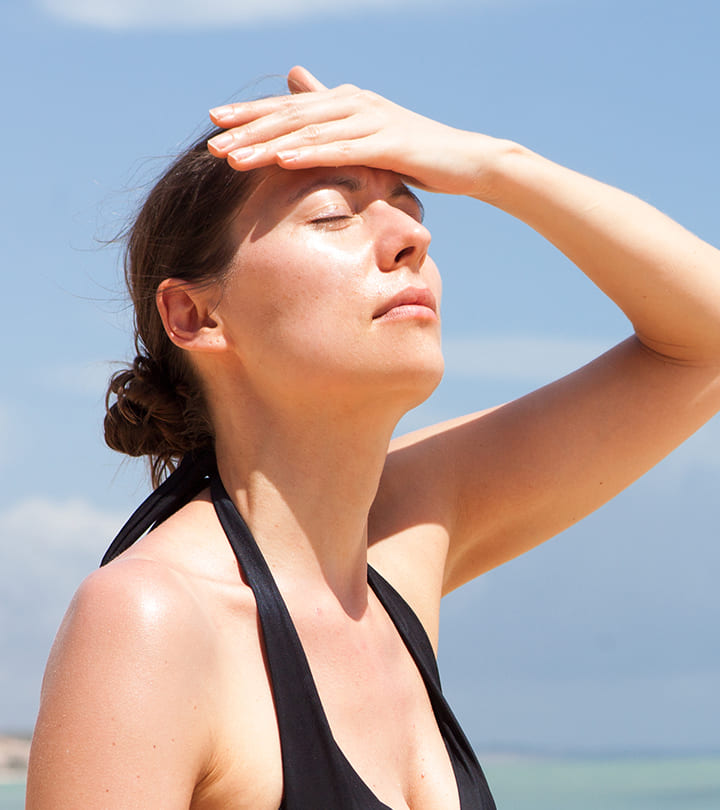Anyone would love to soak in the warm rays of the sun and get some vitamin D, but it also brings along some worries, like sun poisoning or severe sunburn. If you are sensitive to the sun, sun poisoning treatments may help manage the symptoms.
This condition is also called polymorphic light eruption. When you are allergic to the sun, you may develop sun rashes or get a sunburn. This article will help you learn more about sun poisoning, its causes, symptoms, and treatments. Keep reading.
In This Article
Sun Poisoning And Its Complications
Shutterstock
Sun poisoning can be mistaken for a sunburn easily as they have similar symptoms. What sets them apart is that sunburns are an adverse effect of spending too much time in the sun. Also, sunburns are easier to treat. However, sun poisoning is more of an allergic response and is rare, though a bad sunburn can be considered a symptom of this condition.
The worry about this condition is that it is still relatively unknown, and if left untreated for prolonged periods, it can be extremely serious. This is because the sun’s ultraviolet (UV) rays can penetrate the skin and cause burns, DNA damage, aging, sunspots, and melanomas (cancer).
When exposed to the sun, the brown pigments in your skin, called melanin, increase due to UV absorption and protect the skin from burning. But, this is only up to a certain extent.
If the exposure is prolonged, the cells that have been absorbing the UV rays may self-destruct due to the amount of UV damage. This triggers the body’s automatic reaction to repair, leading to inflammation. So over the course of a few hours, it begins to look like a burn. In severe cases, it develops blisters.
UV damage is no joke because sometimes a cell that cannot recover may turn cancerous. So, sun poisoning absolutely needs medical attention.
Learn all about the different types of sun poisoning in the next section.
Types Of Sun Poisoning
There are variations in this condition based on your skin’s reaction to sunlight.
1. Polymorphous Light Eruption (PMLE)
Shutterstock
For people who are not used to exposure to direct sunlight, Polymorphous Light Eruption may be the one to look out for. It has no exact cause, but certain people who live in northern regions are more likely to experience PLME when in tropical climates.
PLME usually flares up in the first few times of exposure and resolves over the summer as the skin gets used to it. Its symptoms are rashes, bumps, and itchiness that usually go away on their own.
2. Solar Urticaria
Shutterstock
With this type, you may experience the symptoms within a few minutes of sun exposure. The symptoms include hives, wheezing, burning, itchiness, and unconsciousness. This may flare up time and again throughout the year. It is best to see a doctor for the management of solar urticaria.
Let’s look at some other signs and symptoms of sun poisoning below so that you can detect the condition and get the appropriate treatment on time.
How To Detect Sun Poisoning
Shutterstock
Sun poisoning may be acute or chronic. In acute cases, it is short-term and can resolve quickly. In chronic cases, there could be an underlying condition causing it and making it last for longer periods.
Its symptoms can vary, depending on the amount of exposure. But most commonly, it feels like an allergic reaction. Some common symptoms are:
- Itchy skin
- Erythema (Skin redness)
- Exfoliation of skin
- Urticaria-like lesions
- Blisters
- Swollen
- Painful skin
- Hyperpigmentation
In more severe cases, one might experience:
- Fever
- Nausea
- Headaches
- Dehydration
- Confusion
- Dizziness
Along with a severe sunburn, you may feel as if you are coming down with the flu. If you notice any of the above symptoms after a sunburn, contact a healthcare professional immediately.
Next, let us look at some treatment options that can provide you with relief from sun poisoning.
Sun Poisoning Treatments
Most sun poisoning treatments involve treating the affected areas and hydration. Depending on how severe it is, your doctor may prescribe the following treatments:
1. Aloe Vera
Shutterstock
This cooling plant’s gel has been used for years to treat wounds and skin issues. It has been observed to have anti-inflammatory properties, which can be beneficial for sunburned skin. It may also soothe the affected areas and provide some relief. However, in certain cases, aloe vera may cause irritation. Make sure you conduct a patch test before using aloe vera liberally on sun-damaged skin.
Related: Using Aloe Vera For Dark Spots On Your Skin: Tips And Precautions
2. Cool Compresses
An icepack or a cold, wet towel may help you deal with the inflammation and pain. Be sure not to use ice directly on the skin, and avoid icing the area for more than 20 minutes.
StyleCraze Says You can also take a cool bath or shower to soothe the inflammation and blisters.
3. Hydration
With dehydration, you tend to lose important body salts that can be replenished with IV fluids. If you are not severely dehydrated, be sure to rehydrate your body with plenty of water and an oral rehydration solution.
Related: 10 Effective Ways To Moisturize Your Skin Naturally
4. Steroid Creams
Your doctor may prescribe a steroid ointment to creams to reduce the pain and course of the sunburn, but they only work for a short period. They are commonly stated as a line of treatment, though more studies are needed to back this claim.
5. Antibiotics
If you develop lesions or blisters, there is a chance you may be prescribed antibiotics to prevent any infection from developing in the affected areas. This is helpful as the blisters may leave the skin exposed.
6. Light Therapy
While it may sound counterproductive, it can be helpful in certain cases. For some people, controlled exposure to a different UV light may help the skin become less sensitive to it. For others, it may help by speeding up the healing process and reducing the pain. Light therapy is known to also control the growth of damaged cells. However, not a lot of research has been conducted to back this claim.
Subscribe
7. Dressing
Proper dressing of the burn wounds can help with the overall healing of the affected areas. Depending on the severity of the burn, your doctor will use the appropriate dressing. This also lowers the chances of it getting infected.
8. Drug Therapy
This differs from situation to situation and person to person. Depending on the severity and cause of your sun poisoning, the doctor may prescribe certain medications to keep the symptoms under control. Additionally, you may also be prescribed medication as a course of treatment in case it is chronic.
9. Nutrition
You may be prescribed certain supplements to help your body recover. While nutritional support for this skin condition requires more studies, certain vitamins like vitamin C can help with antioxidant support for tissue damage. But it is essential to follow a good diet that is high in nutrients to give your body all the boost it needs as it heals.
Prevention is always better than cure, especially when it comes to sun poisoning. Keep reading to learn some ways to avoid this condition.
Related: Can You Use Apple Cider Vinegar For Sunburn?
Preventing Sun Poisoning
1. Reduced Sun Exposure
The longer you stay in the sun, the more susceptible you are to sun-damaged skin and sun poisoning. So, try to reduce your exposure to the sun as much as possible. Stay in shady areas when you are out during the day.
If you want to catch some sun, be mindful of the time of the day. Try to avoid the sun between 10 a.m. to 5 p.m. because this is when the sun rays are the strongest. Also, do check the UV index of your area online when planning a day out. A small step like this could make a huge difference.
Related: 16 Ways To Protect Your Hair From The Summer Sun
2. Sunscreen And Protectants
If you are going to be out in the sun, it is integral to use at least 1 shot glass worth of sunblock on your body and 1/2 teaspoon worth of sunblock on your face and neck. In addition, if you are under direct light (sunbathing) or swimming, reapply it every 2 hours. Otherwise, reapply it every 4 hours.
Along with sunblock, use UVPF clothing, hats, gloves, and shades when stepping out.
StyleCraze Says Ensure you apply sunscreen 15 minutes before stepping out into the sun. Related: How To Choose Sunscreen
3. Caution With Medication
Certain medications make your skin more sensitive to the sun, including birth control, isotretinoin, and topical acids that you use for exfoliation. Do your research when using any medication, and be sure to take extra steps in terms of prevention.
4. Avoid Tanning Beds
Most experts recommend avoiding tanning beds as they use UV lights, which are the main culprits of sun poisoning.
As noted, certain people are more vulnerable to developing this severe condition. Find out who is most at risk in the section below.
Who Is At Risk Of Sun Poisoning?
You are more likely to get sun poisoning if you fall in any one of the following categories:
- Fair-skinned people, regardless of ethnicity
- People on antibiotics
- Cancer patients
- People who reside in high altitudes
- People who frequently indulge in beach and snow activities
- People using certain topical medication/creams
- People with conditions like eczema and lupus
You may develop sun rashes or acquire a sunburn if you are allergic to the sun. Sun poisoning is a dangerous condition. It should not be taken lightly, especially if it is linked to severe sunburns. Repeated sunburns have been linked to an increased risk of skin cancer, so avoid the sun as much as possible. And when going outside, wear UVPF clothes, hats, gloves, and sunglasses in addition to sunscreen. Remember that you cannot treat sun poisoning at home, so get medical assistance right away if you detect any of the symptoms outlined in this article.




